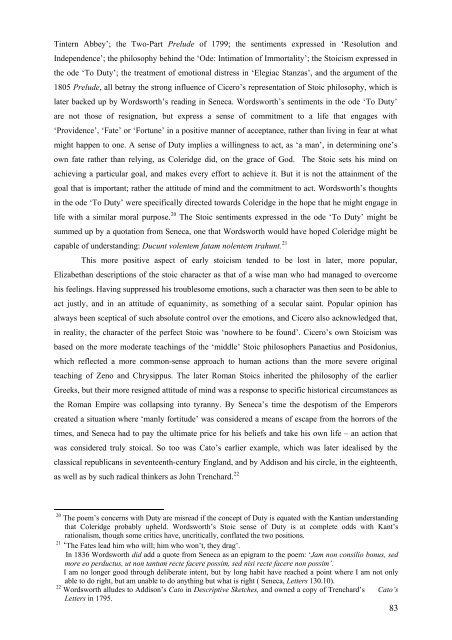Contents - ResearchSpace@Auckland - The University of Auckland
Contents - ResearchSpace@Auckland - The University of Auckland
Contents - ResearchSpace@Auckland - The University of Auckland
You also want an ePaper? Increase the reach of your titles
YUMPU automatically turns print PDFs into web optimized ePapers that Google loves.
Tintern Abbey’; the Two-Part Prelude <strong>of</strong> 1799; the sentiments expressed in ‘Resolution andIndependence’; the philosophy behind the ‘Ode: Intimation <strong>of</strong> Immortality’; the Stoicism expressed inthe ode ‘To Duty’; the treatment <strong>of</strong> emotional distress in ‘Elegiac Stanzas’, and the argument <strong>of</strong> the1805 Prelude, all betray the strong influence <strong>of</strong> Cicero’s representation <strong>of</strong> Stoic philosophy, which islater backed up by Wordsworth’s reading in Seneca. Wordsworth’s sentiments in the ode ‘To Duty’are not those <strong>of</strong> resignation, but express a sense <strong>of</strong> commitment to a life that engages with‘Providence’, ‘Fate’ or ‘Fortune’ in a positive manner <strong>of</strong> acceptance, rather than living in fear at whatmight happen to one. A sense <strong>of</strong> Duty implies a willingness to act, as ‘a man’, in determining one’sown fate rather than relying, as Coleridge did, on the grace <strong>of</strong> God. <strong>The</strong> Stoic sets his mind onachieving a particular goal, and makes every effort to achieve it. But it is not the attainment <strong>of</strong> thegoal that is important; rather the attitude <strong>of</strong> mind and the commitment to act. Wordsworth’s thoughtsin the ode ‘To Duty’ were specifically directed towards Coleridge in the hope that he might engage inlife with a similar moral purpose. 20 <strong>The</strong> Stoic sentiments expressed in the ode ‘To Duty’ might besummed up by a quotation from Seneca, one that Wordsworth would have hoped Coleridge might becapable <strong>of</strong> understanding: Ducunt volentem fatam nolentem trahunt. 21This more positive aspect <strong>of</strong> early stoicism tended to be lost in later, more popular,Elizabethan descriptions <strong>of</strong> the stoic character as that <strong>of</strong> a wise man who had managed to overcomehis feelings. Having suppressed his troublesome emotions, such a character was then seen to be able toact justly, and in an attitude <strong>of</strong> equanimity, as something <strong>of</strong> a secular saint. Popular opinion hasalways been sceptical <strong>of</strong> such absolute control over the emotions, and Cicero also acknowledged that,in reality, the character <strong>of</strong> the perfect Stoic was ‘nowhere to be found’. Cicero’s own Stoicism wasbased on the more moderate teachings <strong>of</strong> the ‘middle’ Stoic philosophers Panaetius and Posidonius,which reflected a more common-sense approach to human actions than the more severe originalteaching <strong>of</strong> Zeno and Chrysippus. <strong>The</strong> later Roman Stoics inherited the philosophy <strong>of</strong> the earlierGreeks, but their more resigned attitude <strong>of</strong> mind was a response to specific historical circumstances asthe Roman Empire was collapsing into tyranny. By Seneca’s time the despotism <strong>of</strong> the Emperorscreated a situation where ‘manly fortitude’ was considered a means <strong>of</strong> escape from the horrors <strong>of</strong> thetimes, and Seneca had to pay the ultimate price for his beliefs and take his own life – an action thatwas considered truly stoical. So too was Cato’s earlier example, which was later idealised by theclassical republicans in seventeenth-century England, and by Addison and his circle, in the eighteenth,as well as by such radical thinkers as John Trenchard. 2220 <strong>The</strong> poem’s concerns with Duty are misread if the concept <strong>of</strong> Duty is equated with the Kantian understandingthat Coleridge probably upheld. Wordsworth’s Stoic sense <strong>of</strong> Duty is at complete odds with Kant’srationalism, though some critics have, uncritically, conflated the two positions.21‘<strong>The</strong> Fates lead him who will; him who won’t, they drag’.In 1836 Wordsworth did add a quote from Seneca as an epigram to the poem: ‘Jam non consilio bonus, sedmore eo perductus, ut non tantum recte facere possim, sed nisi recte facere non possim’.I am no longer good through deliberate intent, but by long habit have reached a point where I am not onlyable to do right, but am unable to do anything but what is right ( Seneca, Letters 130.10).22 Wordsworth alludes to Addison’s Cato in Descriptive Sketches, and owned a copy <strong>of</strong> Trenchard’s Cato’sLetters in 1795.83














